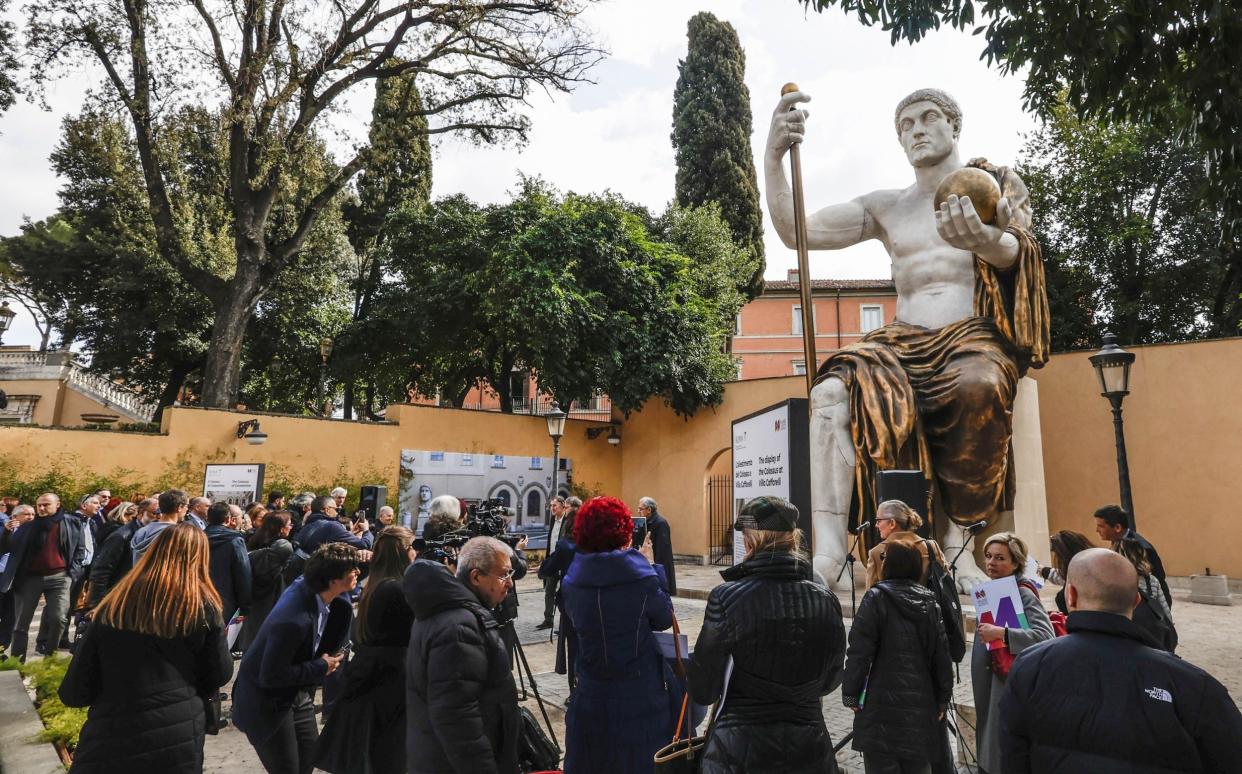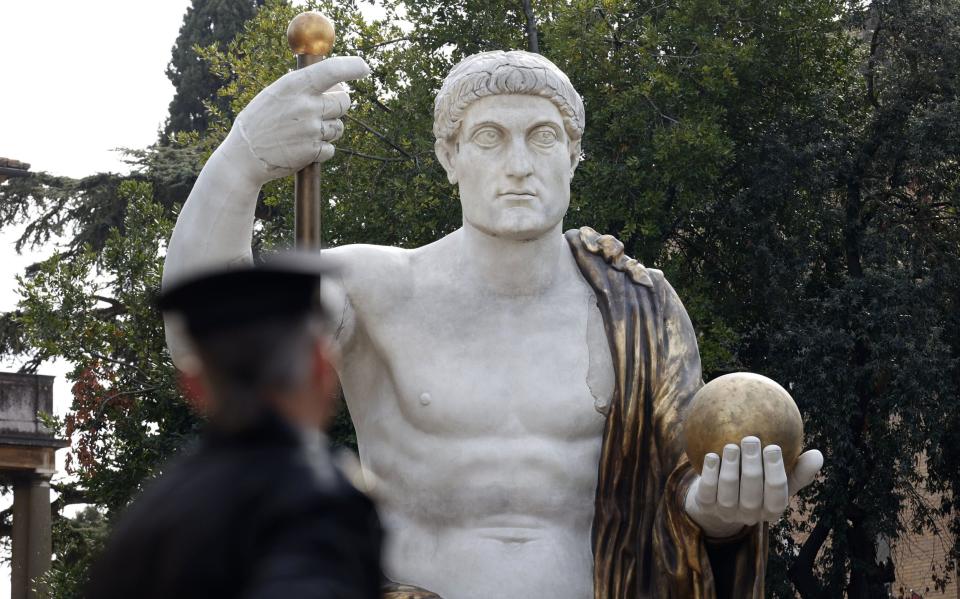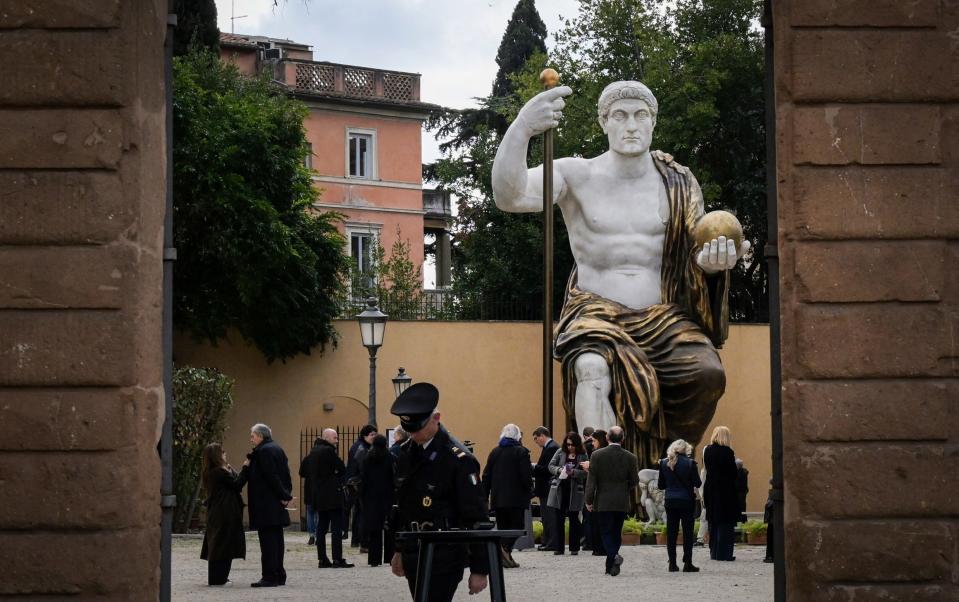British artist helps reconstruct 42 foot statue of Emperor Constantine in Rome

- Oops!Something went wrong.Please try again later.
A colossal statue of the Roman emperor Constantine has been reconstructed by a leading British art expert with the help of marble fragments that survived centuries of war, earthquakes and looting.
The 42ft tall statue of Constantine, who was proclaimed emperor in York after the death of his father and transferred the imperial capital from Rome to Constantinople, was unveiled on Tuesday on top of the Campidoglio, a prominent hill in the heart of the Italian capital.
Experts made 3D scans of the 10 surviving fragments of the ancient statue, including its head, feet and a hand. The project was funded by Prada, but the costs have remained under wraps.
The fragments were discovered in the 15th century in the remains of a Roman temple and were put on display in a courtyard of the Capitoline Museums, just a couple of hundred yards from where the reconstructed statue now stands.
From the 3D scans, experts were able to extrapolate and build up an accurate digital scan of exactly how the fourth-century statue – known as the Colossus of Constantine – would have looked, down to the orb that the emperor held in one hand and a cloak that draped from his shoulder down to his lap.

There are plans to create a second reconstructed statue and locate it at Binchester near Bishop Auckland in County Durham, where the ancient Romans built a fort. Constantine was deployed to the area before being proclaimed emperor in York in AD306.
The task of digitally mapping the fragments and then turning them into an exact replica of the original statue fell to specialist company Factum Foundation, which is headed by Adam Lowe, a British art history expert.
Based in Madrid, Factum Foundation’s digital experts and traditional artisans were able to reproduce every part of the statue in acrylic resin mixed with marble powder. They transported the pieces to Rome and erected the four-ton statue in a garden next to the Capitoline Museums and Rome’s Renaissance town hall.
“After scanning the original 10 fragments we had to understand how they all fit together exactly, for example how the foot fitted onto the shin,” said Mr Lowe.
The original statue of Constantine is believed to have been a reworking of an older cult statue of the god Jupiter.
The Jupiter statue was badly damaged by a lightning bolt in the third century, which may have set the stage for its repurposing by Constantine in the early fourth century.

The association with Jupiter was meant to show Romans that Constantine’s power was divine in origin.
“Constantine took the statue of Jupiter, cut its hair, chiselled off its beard and had it carved in his image,” Mr Lowe said.
The reconstructed statue now stands close to the site of an ancient temple to Jupiter, where the original figure is thought to have stood.
Claudio Parisi Presicce, a senior cultural heritage official, said: “It is believed to be the largest sculpture that was preserved from antiquity, at least in pieces.”
Roberto Gualtieri, the mayor of Rome, attended the presentation of the reconstruction.
“It shows how modern technology can recuperate the masterpieces of the past,” he said.
“Until now, no one had ever tried to understand the relationship between the different fragments.”
Constantine, one of the greatest of emperors, had finally come home, he said, adding: “This is one of the most important places in the world, not just for the history of Rome but for the history of humanity.”
Constantine transformed the Roman Empire by giving official recognition to Christianity and switching the imperial capital to Constantinople, which was named after him.
The recreated statue has been built to last. Mr Lowe said: “It’s waterproof. The main issues it will face will be city grime and bird droppings, so it will need to be cleaned.
“I hope Constantine will look out over Rome for many years to come.”

